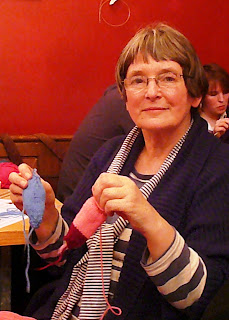
Use 4 double-ended needles. Start at the top and work down and round the cell body like a sock, tapering down to a point where the axon joins on to the cell body. Stitch in your axon, stuff and close off the body, and add your dendrites.
Abbreviations:
DPN: double pointed needle
St: stitch
KFB: knit into front and back of the st = increase
AXON
First make your axon. Cast on 3 stitches onto a DPN. Slide the stitches to the other end and knit from the start. Do this at the end of every row and the piece will curl round on itself, looking like French knitting. Continue until you have made a length of i-cord ~10-15cm long.
CELL BODY
next row: KFB 3 times (6 st) then place 2 st on each of 2 new DPN
- continue working in the round, using 4 DPN
Round 1: KFB, K1 3 times (9 st)
Round 2: KFB, K2 3 times (12 st)
Round 3: KFB, K3 3 times (15 st)
Round 4: K1, M1 for all three needles (3 x 10st = 30st)
- continue working in the round, using 4 DPN
Round 1: KFB, K1 3 times (9 st)
Round 2: KFB, K2 3 times (12 st)
Round 3: KFB, K3 3 times (15 st)
Round 4: K1, M1 for all three needles (3 x 10st = 30st)
Rounds 5-8: K
Rounds 9 onwards: Start to stuff the cell body with toy stuffing as you go
Decrease stitches by reducing by one stitch every other needle as follows:
Decrease stitches by reducing by one stitch every other needle as follows:
needle 1: K2 tog, K8 (9st); needle 2; K (10st); needle 3: K2 tog, K8 (9st)
needle 1: K9 (9st); needle 2; K2 tog, K8 (9st); needle 3: K9 (9st)
needle 1: K2 tog, K7 (8st); needle 2; K9 (9st); needle 3: K2 tog, K7 (8st)
needle 1: K8 (8st); needle 2; K2 tog, K7 (8st); needle 3: K8 (8st)
needle 1: K2 tog, K6 (7st); needle 2; K8 (8st); needle 3: K2 tog, K6 (7st)continue until
needle 1: K3 (3st); needle 2; K2 tog, K2 (3st); needle 3: K3 (3st)
needle 1: K2 tog, K1 (2st); needle 2; K2 tog, K1 (2st); needle 3: K2 tog, K1 (2st)
needle 1: K2 tog, K1 (2st); needle 2; K2 tog, K1 (2st); needle 3: K2 tog, K1 (2st)
Congratulations – you’ve reached the top of the axon!
DENDRITES
Next round: K2 tog 3 times, leaving 3 st
Place these 3 st on a single needle
Continue knitting an i-cord as before, until you reach the desired length.
To make more than one dendrite, you can split the original 6st in half, working 3 on 1 needle and 3 on another to give 2 dendrites. Alternatively, pick up and K 3 st from anywhere on the cell body, then continue to knit as i-cords.
For the ends of the i-cords, you can sew in the loose end of yarn or, as I have done in the picture below, you could thread in a short piece of yarn and knot it over the end of the i-cord to give extra dendritic projections.
Thanks to Caroline for this new version!




